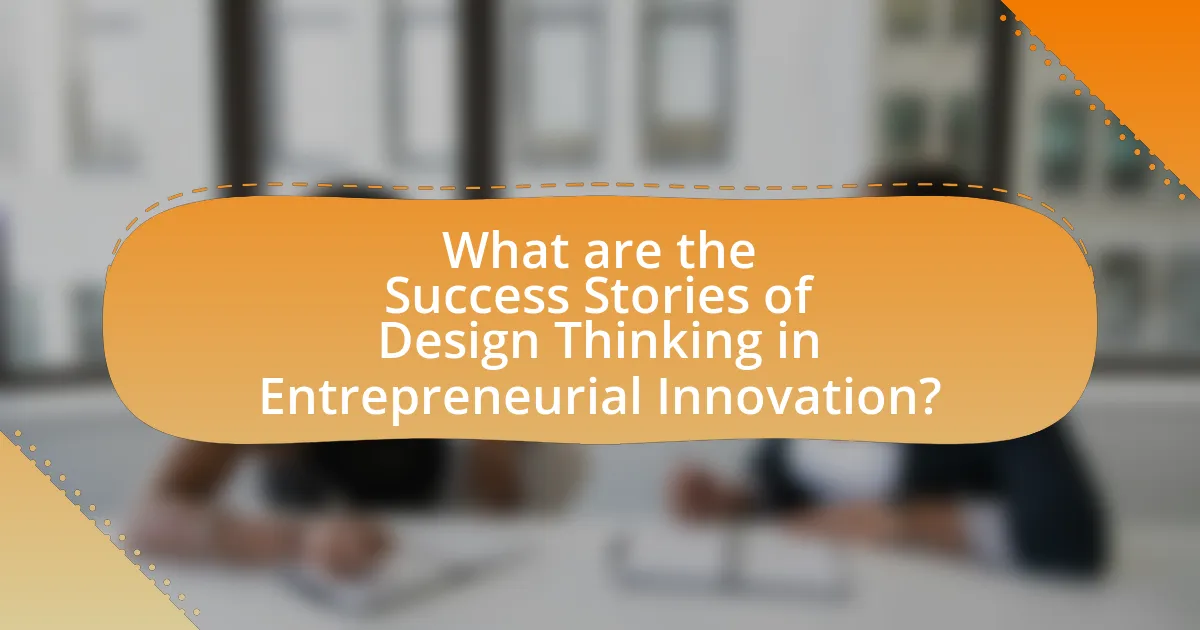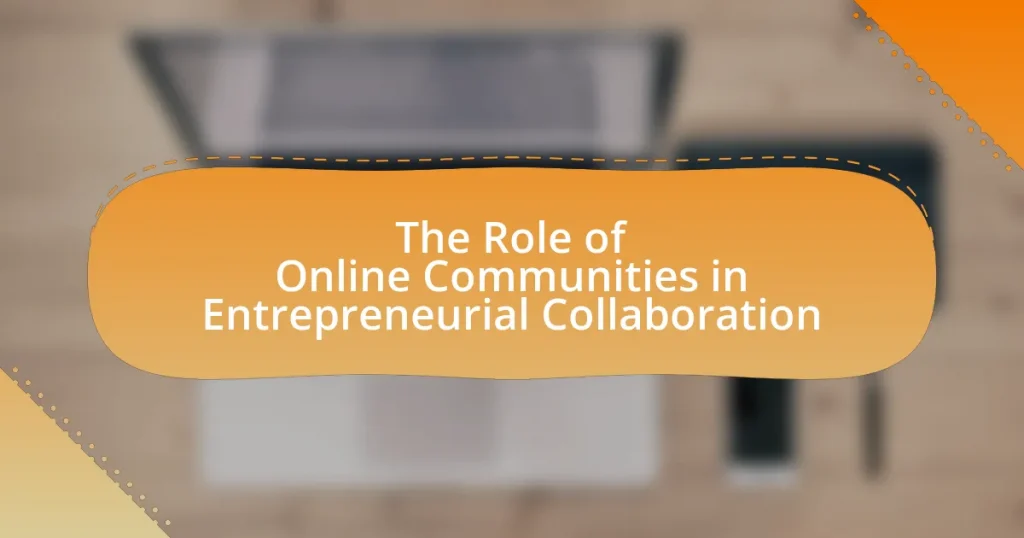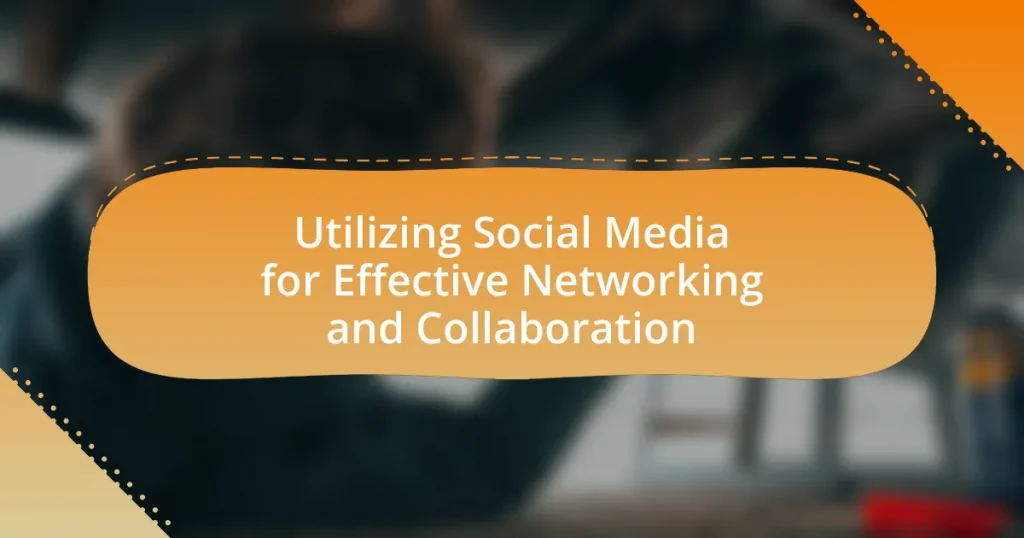Design Thinking is a human-centered approach to innovation that plays a crucial role in fostering entrepreneurial innovation by emphasizing user needs, ideation, prototyping, and testing. The article explores how Design Thinking facilitates problem-solving in entrepreneurship, detailing its key stages: Empathize, Define, Ideate, Prototype, and Test. It highlights the influence of empathy and user-centered design on innovation, the unique advantages it offers to startups, and practical applications in various companies. Additionally, the article addresses challenges entrepreneurs face when adopting Design Thinking and provides best practices for effective implementation, showcasing success stories from organizations like Airbnb and IDEO that have successfully utilized this methodology to drive innovation and enhance customer satisfaction.

What is Design Thinking and its Role in Entrepreneurial Innovation?
Design Thinking is a human-centered approach to innovation that emphasizes understanding user needs, ideation, prototyping, and testing. Its role in entrepreneurial innovation lies in fostering creativity and problem-solving by encouraging entrepreneurs to empathize with users, define problems clearly, ideate solutions, create prototypes, and test them iteratively. This methodology has been shown to enhance product development and service design, as evidenced by companies like Apple and IDEO, which have successfully utilized Design Thinking to create user-centric products that meet market demands.
How does Design Thinking facilitate problem-solving in entrepreneurship?
Design Thinking facilitates problem-solving in entrepreneurship by promoting a user-centered approach that encourages innovation and creativity. This methodology emphasizes empathy, allowing entrepreneurs to deeply understand the needs and challenges of their target audience, which leads to more effective solutions. For instance, a study by the Stanford d.school highlights that Design Thinking can increase the likelihood of successful product development by aligning offerings with customer desires, thereby enhancing market fit. By iterating through prototyping and testing, entrepreneurs can refine their ideas based on real feedback, reducing the risk of failure and increasing the chances of creating viable business solutions.
What are the key stages of the Design Thinking process?
The key stages of the Design Thinking process are Empathize, Define, Ideate, Prototype, and Test. Empathize involves understanding the users and their needs through observation and engagement. Define focuses on articulating the problem based on insights gathered during the Empathize stage. Ideate encourages brainstorming a wide range of ideas and solutions. Prototype involves creating tangible representations of ideas to explore potential solutions. Finally, Test entails evaluating prototypes with users to gather feedback and refine solutions. These stages are iterative, allowing for continuous improvement and innovation in problem-solving.
How do empathy and user-centered design influence innovation?
Empathy and user-centered design significantly influence innovation by ensuring that products and services are tailored to meet the actual needs and preferences of users. This approach leads to more relevant and effective solutions, as it prioritizes understanding user experiences and challenges. For instance, a study by IDEO found that organizations employing user-centered design principles are 60% more likely to launch successful products. By integrating empathy into the design process, innovators can identify pain points and opportunities that may not be apparent through traditional methods, ultimately driving more impactful and user-friendly innovations.
Why is Design Thinking essential for fostering entrepreneurial innovation?
Design Thinking is essential for fostering entrepreneurial innovation because it emphasizes a human-centered approach to problem-solving, which leads to the development of products and services that truly meet user needs. This methodology encourages iterative prototyping and testing, allowing entrepreneurs to quickly validate ideas and pivot based on feedback, thereby reducing the risk of failure. According to a study by the Stanford d.school, companies that adopt Design Thinking principles report a 60% increase in innovation success rates, demonstrating its effectiveness in driving entrepreneurial growth.
What unique advantages does Design Thinking provide to startups?
Design Thinking provides startups with a structured approach to innovation that emphasizes empathy, experimentation, and iterative problem-solving. This methodology enables startups to deeply understand customer needs, leading to the development of products and services that are more likely to succeed in the market. For instance, a study by the Stanford d.school highlights that companies employing Design Thinking report a 30% increase in customer satisfaction due to better alignment with user expectations. Additionally, Design Thinking fosters a culture of collaboration and creativity, which can enhance team dynamics and drive more innovative solutions. This approach not only reduces the risk of failure by validating ideas early through prototyping and testing but also accelerates the development process, allowing startups to adapt quickly to changing market conditions.
How does Design Thinking enhance creativity and collaboration among teams?
Design Thinking enhances creativity and collaboration among teams by promoting a user-centered approach that encourages diverse perspectives and iterative problem-solving. This methodology fosters an environment where team members feel safe to share ideas, leading to increased innovation. Research indicates that teams employing Design Thinking report higher levels of engagement and creativity, as it emphasizes empathy and understanding user needs, which can lead to more effective solutions. For instance, a study by the Stanford d.school highlights that organizations using Design Thinking methodologies experience improved collaboration and creativity, as team members are encouraged to brainstorm freely and build on each other’s ideas.

What are the Practical Applications of Design Thinking in Entrepreneurship?
Design thinking has practical applications in entrepreneurship by enhancing problem-solving, fostering innovation, and improving customer engagement. Entrepreneurs utilize design thinking to empathize with users, define problems clearly, ideate creative solutions, prototype rapidly, and test concepts iteratively. For instance, companies like Airbnb and IDEO have successfully applied design thinking to develop user-centered products and services, leading to increased market relevance and customer satisfaction. Research indicates that organizations employing design thinking report higher levels of innovation and adaptability, as evidenced by a study from the Stanford d.school, which highlights the effectiveness of design thinking in driving business success.
How can entrepreneurs implement Design Thinking in their ventures?
Entrepreneurs can implement Design Thinking in their ventures by following a structured approach that includes empathizing with users, defining problems, ideating solutions, prototyping, and testing. This iterative process allows entrepreneurs to gain deep insights into customer needs, which is essential for creating innovative products or services. For instance, a study by the Stanford d.school highlights that organizations employing Design Thinking report increased customer satisfaction and improved product-market fit, demonstrating its effectiveness in fostering innovation. By actively engaging with users and iterating based on feedback, entrepreneurs can enhance their offerings and drive business success.
What tools and techniques are commonly used in Design Thinking?
Commonly used tools and techniques in Design Thinking include empathy maps, user personas, journey maps, brainstorming sessions, prototyping, and testing. Empathy maps help teams understand user needs and emotions, while user personas provide detailed profiles of target users. Journey maps visualize the user experience, identifying pain points and opportunities for improvement. Brainstorming sessions encourage creative idea generation, and prototyping allows for the development of tangible solutions that can be tested and refined based on user feedback. Testing is crucial for validating ideas and ensuring they meet user needs effectively. These tools and techniques collectively enhance the Design Thinking process, fostering innovation and user-centered solutions.
How can prototyping and testing improve entrepreneurial outcomes?
Prototyping and testing enhance entrepreneurial outcomes by allowing entrepreneurs to validate ideas and gather user feedback early in the development process. This iterative approach reduces the risk of market failure by ensuring that products meet customer needs and preferences before full-scale launch. Research indicates that companies employing prototyping and testing can achieve up to 30% faster time-to-market and a 50% reduction in development costs, as they can identify and address issues promptly. By integrating user insights, entrepreneurs can refine their offerings, leading to higher customer satisfaction and increased chances of business success.
What challenges do entrepreneurs face when adopting Design Thinking?
Entrepreneurs face several challenges when adopting Design Thinking, including resistance to change, lack of understanding of the methodology, and resource constraints. Resistance to change often stems from established organizational cultures that prioritize traditional problem-solving methods over innovative approaches. A lack of understanding can hinder effective implementation, as many entrepreneurs may not fully grasp the iterative nature and user-centered focus of Design Thinking. Additionally, resource constraints, such as limited time and budget, can impede the ability to engage in the extensive research and prototyping phases that are essential to the Design Thinking process. These challenges can significantly affect the successful integration of Design Thinking into entrepreneurial practices.
How can resistance to change be overcome in organizations?
Resistance to change in organizations can be overcome by fostering a culture of open communication and involving employees in the change process. Engaging employees through workshops and feedback sessions allows them to voice concerns and contribute ideas, which can reduce anxiety and build ownership of the change. Research indicates that organizations that implement participatory change management strategies experience higher employee satisfaction and lower resistance rates. For example, a study by Kotter and Schlesinger (2008) highlights that involving employees in decision-making can significantly enhance their commitment to change initiatives.
What strategies can be employed to integrate Design Thinking into company culture?
To integrate Design Thinking into company culture, organizations can implement training programs that focus on empathy, ideation, and prototyping. These programs encourage employees to adopt a user-centered mindset, fostering innovation and collaboration. Research by the Stanford d.school highlights that companies like IDEO have successfully embedded Design Thinking by creating cross-functional teams that work on real-world problems, thus promoting a culture of experimentation and iterative learning. Additionally, leadership support is crucial; leaders must model Design Thinking behaviors and provide resources for teams to engage in creative problem-solving. This approach not only enhances employee engagement but also aligns organizational goals with customer needs, driving entrepreneurial innovation.

What are the Success Stories of Design Thinking in Entrepreneurial Innovation?
Success stories of design thinking in entrepreneurial innovation include companies like Airbnb, which utilized design thinking to enhance user experience by deeply understanding customer needs, leading to a significant increase in bookings and customer satisfaction. Another example is IDEO, a design and consulting firm that applied design thinking to develop the first Apple computer mouse, revolutionizing user interaction with technology. Additionally, Procter & Gamble adopted design thinking to innovate its product development process, resulting in successful launches like Swiffer and Febreze, which significantly boosted sales. These examples demonstrate how design thinking can effectively drive innovation and business success by focusing on user-centered solutions.
Which companies have successfully utilized Design Thinking?
Companies that have successfully utilized Design Thinking include IBM, Apple, and Procter & Gamble. IBM integrated Design Thinking into its development processes, resulting in improved user experiences and increased customer satisfaction. Apple employs Design Thinking to create innovative products, focusing on user-centric design, which has led to its market dominance. Procter & Gamble adopted Design Thinking to enhance product development, resulting in successful launches like Swiffer and Febreze, which significantly boosted their sales. These examples demonstrate how Design Thinking can drive innovation and business success.
What specific innovations resulted from Design Thinking in these companies?
Design Thinking has led to specific innovations in companies such as Airbnb, which redesigned its user experience to enhance customer engagement, resulting in a 30% increase in bookings. Similarly, IBM utilized Design Thinking to streamline its software development process, leading to a 75% reduction in project timelines. Additionally, Procter & Gamble implemented Design Thinking to create the Swiffer, which generated over $1 billion in sales within its first year. These examples demonstrate how Design Thinking has directly contributed to significant product and service innovations across various industries.
How did these companies measure the impact of Design Thinking on their success?
Companies measured the impact of Design Thinking on their success through metrics such as customer satisfaction scores, innovation rates, and revenue growth. For instance, organizations like IBM reported a 300% increase in customer satisfaction after implementing Design Thinking methodologies, which they tracked through user feedback and surveys. Additionally, companies like Procter & Gamble noted a significant rise in product innovation, with a reported 30% increase in successful product launches attributed to Design Thinking processes. These metrics provide concrete evidence of the positive correlation between Design Thinking practices and overall business performance.
What lessons can be learned from these success stories?
Success stories in harnessing design thinking to foster entrepreneurial innovation reveal several key lessons. Firstly, the importance of empathy in understanding user needs is critical; successful entrepreneurs prioritize user feedback to refine their products. For instance, companies like Airbnb utilized user insights to enhance their platform, leading to significant growth. Secondly, iterative prototyping allows for rapid testing and learning, which accelerates innovation; firms that embrace this approach, such as IDEO, have consistently delivered successful products. Lastly, collaboration across diverse teams fosters creativity and leads to more innovative solutions, as demonstrated by companies like Apple, which integrates cross-disciplinary expertise to drive product development. These lessons underscore the effectiveness of design thinking in creating impactful entrepreneurial ventures.
How can these lessons be applied to new entrepreneurial ventures?
Lessons from design thinking can be applied to new entrepreneurial ventures by emphasizing user-centered approaches, iterative prototyping, and collaborative problem-solving. By focusing on understanding customer needs through empathy, entrepreneurs can create products and services that resonate with their target audience, leading to higher market acceptance. Iterative prototyping allows for rapid testing and refinement of ideas, reducing the risk of failure and ensuring that the final offering is well-aligned with user expectations. Collaborative problem-solving fosters diverse perspectives, enhancing creativity and innovation, which are crucial for developing unique solutions in competitive markets. These principles have been validated by successful companies like IDEO, which has demonstrated that design thinking can lead to significant improvements in product development and customer satisfaction.
What common traits do successful entrepreneurs exhibit when using Design Thinking?
Successful entrepreneurs using Design Thinking exhibit traits such as empathy, creativity, and resilience. Empathy allows them to understand user needs deeply, which is essential for creating solutions that resonate with customers. Creativity enables them to generate innovative ideas and approaches, fostering unique solutions to complex problems. Resilience helps them navigate setbacks and iterate on their designs, ensuring continuous improvement and adaptation. These traits collectively enhance their ability to leverage Design Thinking effectively, leading to successful entrepreneurial outcomes.
What are the Best Practices for Harnessing Design Thinking in Entrepreneurship?
The best practices for harnessing design thinking in entrepreneurship include empathizing with users, defining clear problems, ideating innovative solutions, prototyping rapidly, and testing iteratively. Empathizing with users involves understanding their needs and experiences, which can be achieved through interviews and observations. Defining clear problems ensures that the focus remains on addressing specific user challenges, leading to more effective solutions. Ideation encourages brainstorming diverse ideas, fostering creativity and collaboration among team members. Rapid prototyping allows entrepreneurs to create tangible representations of ideas quickly, facilitating feedback and refinement. Finally, iterative testing helps validate concepts and improve them based on real user interactions, ensuring that the final product aligns with market needs. These practices are supported by research indicating that companies employing design thinking methodologies, such as IDEO and Stanford d.school, have seen increased innovation and customer satisfaction.
How can entrepreneurs cultivate a Design Thinking mindset within their teams?
Entrepreneurs can cultivate a Design Thinking mindset within their teams by fostering a culture of empathy, experimentation, and collaboration. This involves encouraging team members to deeply understand user needs through direct engagement and feedback, which is essential for identifying real problems to solve. Additionally, entrepreneurs should promote iterative prototyping and testing, allowing teams to learn from failures and refine solutions based on user input. Research indicates that organizations that embrace Design Thinking report higher levels of innovation and customer satisfaction, as seen in the success of companies like IDEO and Apple, which prioritize user-centered design in their processes. By implementing these practices, entrepreneurs can effectively instill a Design Thinking approach that enhances creativity and problem-solving within their teams.
What are the key steps to ensure effective implementation of Design Thinking?
The key steps to ensure effective implementation of Design Thinking include empathizing with users, defining the problem, ideating solutions, prototyping, and testing. Empathizing involves understanding user needs through observation and engagement, which lays the foundation for identifying the right problem to solve. Defining the problem clearly helps to focus the team’s efforts on a specific challenge. Ideation encourages brainstorming a wide range of ideas, fostering creativity and innovation. Prototyping allows teams to create tangible representations of ideas, facilitating feedback and iteration. Finally, testing involves gathering user feedback on prototypes to refine solutions. These steps are supported by the iterative nature of Design Thinking, which emphasizes continuous learning and adaptation based on user insights.



